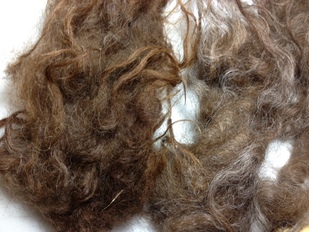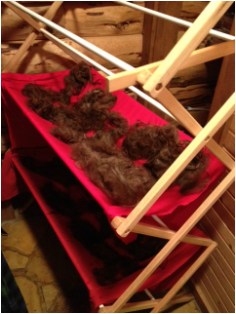
Why did I want Icelandic? The answer is simple - it's Period! Icelandic sheep were taken to Iceland by the Vikings and have remain fairly unchanged since that time (and are considered a primitive, unimproved breed of sheep). They also come in a broad range of colors and, honestly, they just look cool! Eventually, I hope that life works out and I can start my own flock of Icelandic sheep.

The first step is to wash the wool. I found a bit of conflicting information online about the temperature of the water, one site listed 120 degrees and another listed 160. There was a broad range that fell in the middle as well.
I ended up working at about 130-135 because that is what the tap plus a little water heated on the stove gave me. It seemed to work well enough for my purposes.
Above is the fleece soaking in mesh bags meant for washing delicates. I filled (but did not tightly pack) the bags and gently submerged them in heated water to which I added 2 tablespoons of Dawn. After 15 minutes, I transferred the bags to a rinse that was the same temperature as the soapy water. I did not wring the bags, but I did gently squeeze the excess water from them.
One thing that all instructions had in common was the admonition to not agitate the wool in any manner. One site even went as far as saying to not look at it funny, because it will felt if you do so. I took extreme care and it all seems to be working so far. I think I have a good working method at this point. (No, I am not ready to try the washing machine yet, as I am worried that i would accidentally let it start to agitate and I would have a large mass of ruined wool.)
The dissolved lanolin left the wash bath looking a very dismal brown, but after 2 or 3 rinses (15 minutes each), the water was clear and I deemed the wool clean enough to be set out to dry. (I will note here, that the Icelandic was not very greasy at all, especially not compared to the bag of Shetland I am going to prepare next. I am aware that I might have to adjust my water temperature, amount of detergent or amount of washes when I process that fleece.)
I used my Pennsic laundry rack for drying the locks. Initially, my thought was to build a series of frames with screen tacked to them that I could lay the locks on to dry. However, I have not had time to build the screens, so looked for another alternative. My first try is pictured below on the left. I used scrap fabric draped over the frame and secured underneath with D-clips. The top layer was cotton broadcloth, which did not allow the water to drain away. Below that was a cotton gauze, which definitely let the water escape, but stretched alot and caused some of the fleece to slump onto itself.
My second try involved cutting up a mosquito net canopy and stretching that over the frame and securing it with pins. In addition to the mesh, I used a salad spinner to remove some of the excess water from the fleece before laying it out to dry. This worked amazingly well.

Initially, I was thinking of spinning this fairly thick to eventually weave a mat or rug, but the colors are so nice, and has a nice lustre, so now I am not sure.
| Icelandic sheep actually have two coats. There is a long, lustrous layer of wool that is called the tog. It is wavy and very very strong. In this case, it is the darkest hair on the sheep - ranging from very dark brown to near black. And when I said it is long, I mean it. I found some locks that had tog over 7 inches! The undercoat, or the thel, is very fine and amazingly soft. It, unlike the tog, is very short, maybe around 3 inches on this particular fleece. It looks all fluffy and fuzzy compared to the longer shiny wool. The color of this ranges from medium brown to silvery white. Historically, the tog and thel could either be spun together or it could be separated and spun as two different yarns. I did experiment with dividing the types of wool (fairly easy to do by grasping the cut end and just pulling on the longest locks). You can see on the right the two types of fibre together (above) and separated (below). I do not plan to pull apart all of the fleece in this lot, but it might be something with which I eventually experiment further. I can imagine a warm, soft garment out of the thel that can be worn right next to my skin. Or perhaps a garment with a warp spun out of the stronger, longer tog and the weft from the fluffy thel. So many possibilities! |

I had several sets of instructions, all slightly different, printed off regarding how to comb wool. I tried all of these methods and think that for the most part I like those from the Woolery the best. ( http://www.woolery.com/store/pc/How-to-Use-Viking-Wool-Combs-d15.htm )
To the left you can see one of the combs loaded with locks that have been teased open by hand (I just flicked at them a bit with a hair pick).

The sliver is a length of organized fibres that are ready to be spun. Of course, I have not yet decided what I will do with this wool, but I had to see what they looked like spun so I grabbed a spindle and twisted a small length of yarn. I am pleasantly surprised with nice sheen it has when spun (the photo does not do it justice at all).
So now I just need to wash the remaining batch, comb it all and then figure out what the heck I am going to make...





 RSS Feed
RSS Feed